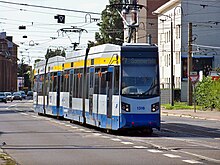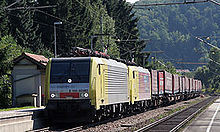Multiple traction



If several locomotives , for example locomotives , jointly transport a train , this is referred to as a multiple traction . All of these vehicles run regularly on the train and are controlled remotely from the first vehicle using a multiple control system; this is a remote control created by connecting cables from the front driver's cab to the rear motor vehicle. The simplest multiple traction is the double traction , i.e. driving with two locomotives at one end of the train or coupling two multiple units (see also wings ). Similarly, there are triple traction , quadruple traction, etc .; In the case of locomotives, the tensile strength of the coupling to the first car limits the possible number of locomotives. On the Austrian Federal Railways , the double traction is referred to as a tandem , the remote-controlled traction vehicle as a tandem traction vehicle. The world's first multiple control system was used at the Budapest Metró in 1895 .
Demarcation
The following are to be distinguished from the multiple traction:
- Multiple locomotives (e.g. double locomotives ) and articulated multiple units in which a single locomotive consists of several (closely) coupled units that cannot be operationally separated or can only be separated in exceptional cases
- A leader in which a locomotive is additionally harnessed to a train without a remote control connection
- Pushing , whereby a train is temporarily pushed by an additional locomotive that is not remotely controlled, possibly not even coupled to the train.
- Car locomotive , if in addition to the locomotive, a non-working motor vehicle is placed on the train as a carriage for transfer - in a sense the functional reversal of a locomotive train .
With wagon trains, especially in freight traffic , more than one locomotive is often necessary to be able to move heavy trains on certain routes.
Special forms
sandwich
The locomotive sandwich (more rarely called a tandem , in Switzerland called a double shuttle train ), d. H. Driving with two locomotives at opposite ends of a wagon train differs from double traction in that it has a lower coupling load and push-pull capability without the need for a control car . In the case of cable remote control, however, the trolleys must offer the option of coupling through the control line.
Distributed traction
With distributed traction , locomotives or groups of locomotives run not only at the ends, but also in the middle of a train. This makes it possible to apply greater tensile forces to a train without overstressing the couplings. In passenger transport, the distributed traction is mainly used to enable faster coupling of two units without having to separate the train from the locomotive beforehand, as is the case with the Railjet of the Austrian Federal Railways .
In Central and Western Europe, multiple traction forms are generally no longer common in freight transport, apart from single double traction, although the SBB carried out tests with radio-controlled intermediate and push locomotives on the Gotthard Railway in the 1990s . Since the Lötschberg and Gotthard Base Tunnels went into operation, the time-consuming intermediate and pushing service has become rare in Switzerland too.
There are freight trains several kilometers long in the USA , Australia and South Africa . The high train weights and the great length of the trains require distributed traction (English: Distributed Power ). There can be up to twelve locomotives per train, as is the case, for example, on the Sishen – Saldanha railway line in South Africa. The high strength of the Janney couplings used for such cases allows the use of up to four six-axle locomotives on the Zugspitze.
A-unit and B-unit

In the United States, driverless diesel locomotives , known as B-units or boosters, were developed for the transportation of heavy freight trains in multiple traction . These were controlled from an A-Unit, i.e. a locomotive with a driver's cab.
Guided railcars on the tram
There are a few so-called service vehicles in the tram sector . These are powered, but do not have a fully-fledged driver's cab and therefore cannot walk on the Zugspitze. In many subway companies, railcars without a driver's cab are also used.
Control types

In the age of steam locomotives, there was no multiple traction in the current sense, but actually only a leader or a post; all locomotives were staffed and controlled individually, communication was carried out by whistle signals.
In Europe today, locomotives are generally controlled via line connections; The vehicles' control computers communicate via bus cables , which also have to be routed through the intermediate car . Sometimes only identical vehicles are capable of traction with each other. In Germany and Switzerland , many locomotives and control cars can be controlled multiple times among each other. See also: multiple control .
The distributed traction of heavy freight trains is usually carried out by radio remote control or, more rarely, via an existing cable for the electropneumatic brake .
See also
- Multiple control , term for multiple traction and push-pull train control in Switzerland
- Trolleybus double traction
Web links
Individual evidence
- ↑ Harald Marincig: 60 Years of the Vienna Electric City Railways 1925–1985 , Wiener Stadtwerke - Verkehrsbetriebe, Vienna 1985, p. 4
